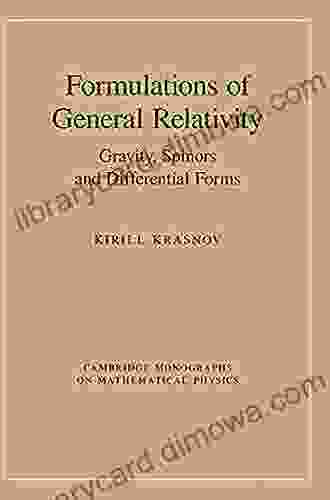Formulations of General Relativity: A Comprehensive Guide to the Theory of Gravity

5 out of 5
| Language | : | English |
| File size | : | 12482 KB |
| Text-to-Speech | : | Enabled |
| Screen Reader | : | Supported |
| Enhanced typesetting | : | Enabled |
| Print length | : | 404 pages |
| X-Ray for textbooks | : | Enabled |
General relativity, developed by Albert Einstein in the early 20th century, is the most accurate theory of gravity we have today. It has revolutionized our understanding of the universe and has had a profound impact on our understanding of space, time, and the cosmos.
General relativity is a complex theory, and there are several different ways to formulate it. Each formulation offers a different perspective on the theory and highlights different aspects of its mathematical structure and physical interpretation.
In this article, we will explore the different formulations of general relativity and discuss their strengths and weaknesses. We will also provide a comprehensive guide to understanding the theory of gravity, from its basic principles to its most advanced applications.
The Lagrangian Formulation
The Lagrangian formulation of general relativity is based on the principle of least action. This principle states that the physical system will take the path that minimizes the action, which is a quantity that is related to the energy of the system.
The Lagrangian formulation of general relativity is a very powerful tool. It allows us to derive the equations of motion for the gravitational field and to study the behavior of gravitational waves.
The Hamiltonian Formulation
The Hamiltonian formulation of general relativity is based on the principle of least action, but it is expressed in terms of the Hamiltonian, which is a quantity that is related to the energy of the system.
The Hamiltonian formulation of general relativity is a very powerful tool. It allows us to study the dynamics of gravitational systems and to understand the behavior of black holes and other compact objects.
The Tetrad Formulation
The tetrad formulation of general relativity is based on the idea of a tetrad, which is a set of four vectors that form a basis for the tangent space at each point in spacetime.
The tetrad formulation of general relativity is a very elegant and powerful tool. It allows us to understand the relationship between general relativity and other theories of physics, such as electromagnetism and quantum mechanics.
The Spinor Formulation
The spinor formulation of general relativity is based on the idea of a spinor, which is a mathematical object that has both a vector and a spinor index.
The spinor formulation of general relativity is a very powerful tool. It allows us to study the behavior of fermions, which are particles that have half-integer spin, in curved spacetime.
Applications of General Relativity
General relativity has a wide range of applications in astrophysics, cosmology, and gravitational physics.
In astrophysics, general relativity is used to study the behavior of stars, black holes, and other compact objects. It is also used to study the formation and evolution of galaxies and the large-scale structure of the universe.
In cosmology, general relativity is used to study the origin and evolution of the universe. It is also used to study the behavior of dark matter and dark energy, which are two of the most mysterious and important components of the universe.
In gravitational physics, general relativity is used to study the behavior of gravitational waves. Gravitational waves are ripples in spacetime that are produced by the acceleration of massive objects. The study of gravitational waves is a new and exciting field of research, and it is providing us with new insights into the nature of gravity and the universe.
General relativity is a complex and powerful theory that has revolutionized our understanding of the universe. The different formulations of general relativity offer different perspectives on the theory and highlight different aspects of its mathematical structure and physical interpretation.
In this article, we have explored the different formulations of general relativity and discussed their strengths and weaknesses. We have also provided a comprehensive guide to understanding the theory of gravity, from its basic principles to its most advanced applications.
General relativity is a beautiful and elegant theory that has had a profound impact on our understanding of the universe. It is a theory that continues to challenge and inspire us, and it is a theory that will continue to shape our understanding of the universe for many years to come.
5 out of 5
| Language | : | English |
| File size | : | 12482 KB |
| Text-to-Speech | : | Enabled |
| Screen Reader | : | Supported |
| Enhanced typesetting | : | Enabled |
| Print length | : | 404 pages |
| X-Ray for textbooks | : | Enabled |
Do you want to contribute by writing guest posts on this blog?
Please contact us and send us a resume of previous articles that you have written.
 Book
Book Novel
Novel Page
Page Chapter
Chapter Text
Text Story
Story Genre
Genre Reader
Reader Library
Library Paperback
Paperback E-book
E-book Magazine
Magazine Newspaper
Newspaper Paragraph
Paragraph Sentence
Sentence Bookmark
Bookmark Shelf
Shelf Glossary
Glossary Bibliography
Bibliography Foreword
Foreword Preface
Preface Synopsis
Synopsis Annotation
Annotation Footnote
Footnote Manuscript
Manuscript Scroll
Scroll Codex
Codex Tome
Tome Bestseller
Bestseller Classics
Classics Library card
Library card Narrative
Narrative Biography
Biography Autobiography
Autobiography Memoir
Memoir Reference
Reference Encyclopedia
Encyclopedia Anya Mckee
Anya Mckee Anna Esaki Smith
Anna Esaki Smith Anna Morgan
Anna Morgan Ann Roberts
Ann Roberts L S Murphy
L S Murphy Arnold Wesker
Arnold Wesker Maris Wicks
Maris Wicks Michael Fraiman
Michael Fraiman Apuleius
Apuleius Annette Laing
Annette Laing Annie Schrank
Annie Schrank Anvarkhuja Mukhamedov
Anvarkhuja Mukhamedov Jessica E Bennett
Jessica E Bennett Ann Swinfen
Ann Swinfen Ann Howard Creel
Ann Howard Creel Anna Nguyen
Anna Nguyen Anita Naik
Anita Naik Mark Webber
Mark Webber Mel Taylor
Mel Taylor Richard Hoffer
Richard Hoffer
Light bulbAdvertise smarter! Our strategic ad space ensures maximum exposure. Reserve your spot today!

 William FaulknerUnlocking the Secrets of Alternative Investments: Dive into "Hedge Funds and...
William FaulknerUnlocking the Secrets of Alternative Investments: Dive into "Hedge Funds and...
 Art MitchellCompany Ill Seen Ill Said And Worstward Ho: An Anthology of Forgotten Stories...
Art MitchellCompany Ill Seen Ill Said And Worstward Ho: An Anthology of Forgotten Stories...
 Bobby HowardUnveiling the Enigmatic World of Accents: Discover the Linguistics in "The...
Bobby HowardUnveiling the Enigmatic World of Accents: Discover the Linguistics in "The... Curtis StewartFollow ·3.1k
Curtis StewartFollow ·3.1k Bryson HayesFollow ·16.3k
Bryson HayesFollow ·16.3k Luke BlairFollow ·2.9k
Luke BlairFollow ·2.9k J.D. SalingerFollow ·11.7k
J.D. SalingerFollow ·11.7k Carlos FuentesFollow ·7.8k
Carlos FuentesFollow ·7.8k Ryūnosuke AkutagawaFollow ·6.3k
Ryūnosuke AkutagawaFollow ·6.3k Ethan MitchellFollow ·15.7k
Ethan MitchellFollow ·15.7k Fletcher MitchellFollow ·12.9k
Fletcher MitchellFollow ·12.9k

 Anton Chekhov
Anton ChekhovMother Goose The Old Nursery Rhymes Illustrated By Arthur...
A Journey Through the Enchanted Gardens of...

 Alexander Blair
Alexander BlairUnleash the Power of Imagination: Exploring the...
A Literary...

 Harry Hayes
Harry Hayes50 Quick and Easy Ways to Become Brilliant at Project...
Project stakeholder...

 Gus Hayes
Gus HayesSimple Practical Tips To Understand The Basics Of...
: The Looming Threat of...

 Connor Mitchell
Connor MitchellUnleash Your Literary Superpowers: Immerse Yourself in...
Welcome to a Captivating Universe of...
5 out of 5
| Language | : | English |
| File size | : | 12482 KB |
| Text-to-Speech | : | Enabled |
| Screen Reader | : | Supported |
| Enhanced typesetting | : | Enabled |
| Print length | : | 404 pages |
| X-Ray for textbooks | : | Enabled |








